英语作文写作之Description_描写
人物描写英语作文
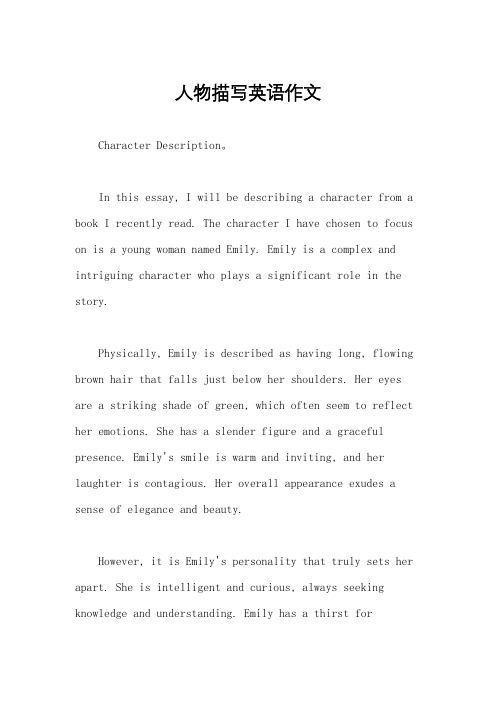
人物描写英语作文Character Description。
In this essay, I will be describing a character from a book I recently read. The character I have chosen to focus on is a young woman named Emily. Emily is a complex and intriguing character who plays a significant role in the story.Physically, Emily is described as having long, flowing brown hair that falls just below her shoulders. Her eyes are a striking shade of green, which often seem to reflect her emotions. She has a slender figure and a graceful presence. Emily's smile is warm and inviting, and her laughter is contagious. Her overall appearance exudes a sense of elegance and beauty.However, it is Emily's personality that truly sets her apart. She is intelligent and curious, always seeking knowledge and understanding. Emily has a thirst forlearning and is constantly seen with a book in her hand. Her passion for literature and art is evident in her conversations and the way she expresses herself. She has a way with words and can captivate anyone with herstorytelling abilities.Emily is also known for her kind and compassionate nature. She genuinely cares about others and is always willing to lend a helping hand. She is empathetic and understanding, making her a trusted confidante for her friends. Emily has a way of making people feel valued and appreciated, and she has a knack for bringing out the best in others.Despite her gentle demeanor, Emily possesses a strong sense of determination and resilience. She faces challenges head-on and does not easily give up. She has a strong moral compass and stands up for what she believes in. Emily is not afraid to speak her mind and fight for justice, even if it means going against popular opinion.Another notable aspect of Emily's character is hercreativity and imagination. She has a unique way of seeing the world, often finding beauty in the simplest of things. Emily has a talent for painting and writing, using these mediums to express her thoughts and emotions. Her artwork is vibrant and full of life, reflecting her own vibrant personality.In conclusion, Emily is a fascinating character who possesses both physical beauty and inner strength. Her intelligence, kindness, and creativity make her a memorable individual in the story. Through her actions and words, Emily leaves a lasting impression on those she encounters. She is a character that readers can easily connect with and admire.。
给出细节的描述英语作文
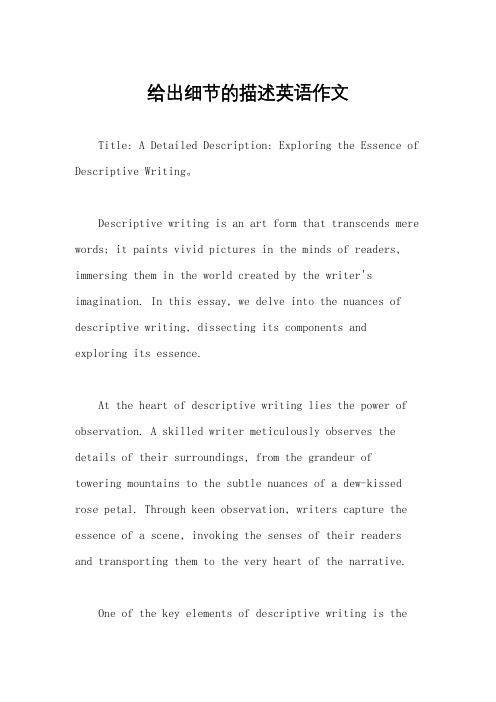
给出细节的描述英语作文Title: A Detailed Description: Exploring the Essence of Descriptive Writing。
Descriptive writing is an art form that transcends mere words; it paints vivid pictures in the minds of readers, immersing them in the world created by the writer's imagination. In this essay, we delve into the nuances of descriptive writing, dissecting its components and exploring its essence.At the heart of descriptive writing lies the power of observation. A skilled writer meticulously observes the details of their surroundings, from the grandeur of towering mountains to the subtle nuances of a dew-kissed rose petal. Through keen observation, writers capture the essence of a scene, invoking the senses of their readers and transporting them to the very heart of the narrative.One of the key elements of descriptive writing is theuse of vivid imagery. By employing sensory language,writers engage the reader's imagination, allowing them to see, hear, smell, taste, and touch the world being depicted on the page. For example, instead of simply stating that the sky is blue, a descriptive writer might evoke the image of a cerulean canopy stretching endlessly overhead, punctuated by wisps of cotton candy clouds.Furthermore, descriptive writing is characterized byits attention to detail. Every aspect of a scene is carefully considered, from the play of light and shadow to the texture of a rough-hewn stone. By painting a rich tapestry of detail, writers create a world that feels tangible and alive, inviting readers to step into its embrace and lose themselves within its folds.Moreover, descriptive writing often employs figurative language to enhance its impact. Metaphors, similes, and personification lend depth and resonance to the narrative, allowing writers to convey complex emotions and ideas with clarity and precision. For instance, a sunset might be likened to a blazing inferno, casting long shadows thatdance like ghosts across the landscape.In addition to its aesthetic qualities, descriptive writing serves a practical purpose in literature. By immersing readers in the sensory experience of a scene, writers evoke empathy and understanding, forging a deeper connection between audience and narrative. Whetherdescribing the bustling streets of a metropolis or the tranquil beauty of a secluded forest glade, descriptive writing invites readers to see the world through the eyesof another, fostering empathy and compassion in the process.In conclusion, descriptive writing is a powerful toolfor communication and expression. By harnessing the powerof observation, imagery, detail, and figurative language, writers create immersive worlds that captivate the imagination and stir the soul. Whether evoking the sights, sounds, and smells of a bustling marketplace or the quiet serenity of a moonlit garden, descriptive writing invites readers to embark on a journey of the senses, where every word is a brushstroke on the canvas of the mind.。
description 英语作文
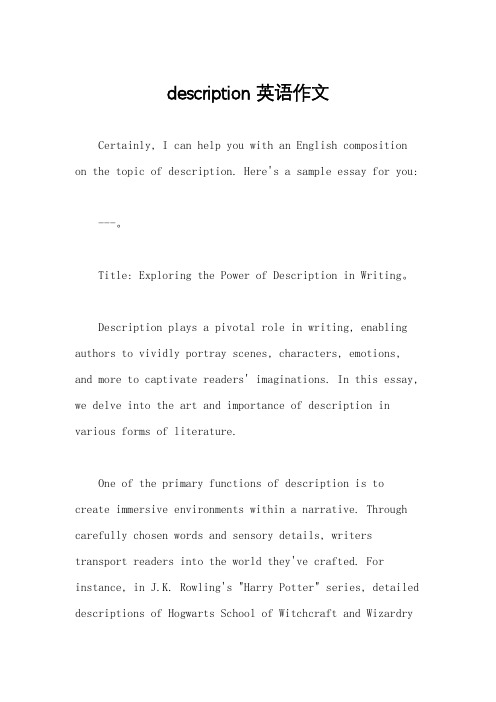
description 英语作文Certainly, I can help you with an English composition on the topic of description. Here's a sample essay for you:---。
Title: Exploring the Power of Description in Writing。
Description plays a pivotal role in writing, enabling authors to vividly portray scenes, characters, emotions, and more to captivate readers' imaginations. In this essay, we delve into the art and importance of description in various forms of literature.One of the primary functions of description is to create immersive environments within a narrative. Through carefully chosen words and sensory details, writers transport readers into the world they've crafted. For instance, in J.K. Rowling's "Harry Potter" series, detailed descriptions of Hogwarts School of Witchcraft and Wizardryimmerse readers in its magical halls, making them feel like they're part of the wizarding world.Moreover, description breathes life into characters, making them more relatable and memorable. By delineating physical attributes, personality traits, and quirks, authors forge connections between readers and characters. Take, for example, the iconic character of Sherlock Holmes created by Sir Arthur Conan Doyle. Doyle's meticulous descriptions of Holmes' deductive prowess, along with his distinctive deerstalker hat and pipe, contribute to the character's enduring appeal.In addition to setting and character portrayal, description enhances mood and atmosphere in writing. By employing evocative language and sensory imagery, writers can evoke a wide range of emotions in readers. Consider Edgar Allan Poe's "The Raven," where the bleak and haunting description of the raven's visit creates an atmosphere of melancholy and foreboding, leaving a lasting impact on readers.Furthermore, description is instrumental in conveying themes and messages within a story. Through symbolic descriptions and metaphorical language, authors can layer their narratives with deeper meanings. For instance, in George Orwell's "1984," the grim descriptions of the totalitarian regime's oppressive tactics serve as a stark commentary on surveillance and control in society.Effective description also relies on the use of figurative language, such as similes, metaphors, and personification, to add depth and nuance to writing. These literary devices help paint vivid pictures in readers' minds, enhancing their understanding and emotional engagement with the text.In conclusion, description is a powerful tool in the hands of skilled writers, allowing them to create richly detailed worlds, compelling characters, immersive atmospheres, and profound thematic layers in their works. Through the artful use of description and literary devices, writers can craft narratives that resonate deeply with readers, leaving a lasting impression long after the finalpage is turned.---。
有关描述的英语作文

有关描述的英语作文英文回答:Description is a crucial aspect of writing that helps readers visualize and understand the details of a scene, character, or event. When it comes to describing something, it's important to use vivid language that appeals to the senses and creates a clear picture in the reader's mind.For example, when describing a beautiful sunset, I might say "The sky was painted with hues of pink, orange, and purple, casting a warm glow over the horizon." This description not only conveys the colors of the sunset but also evokes a sense of warmth and beauty.Using descriptive language can also help create a more engaging and immersive reading experience. Instead of simply stating that a character is sad, I could describe their emotions in more detail by saying "Tears welled up in her eyes, her shoulders slumped, and a heavy sigh escapedher lips." This not only tells the reader that thecharacter is sad but also allows them to feel thecharacter's emotions more deeply.In addition to using descriptive language, it's also important to vary the types of descriptions used in writing. This can include physical descriptions, emotional descriptions, and sensory descriptions. By incorporating a variety of descriptive elements, writers can create a more well-rounded and dynamic picture for their readers.Overall, description plays a key role in bringingwriting to life and engaging readers on a deeper level. By using vivid language, varied descriptions, and specific details, writers can paint a rich and immersive picturethat captivates their audience.中文回答:描述是写作中至关重要的一个方面,它帮助读者形象地理解场景、人物或事件的细节。
英语作文写作之Description_描写[优质ppt]
![英语作文写作之Description_描写[优质ppt]](https://img.taocdn.com/s3/m/dee4e3f265ce0508763213e7.png)
Assignment- Descriptive Essay
Remember: you need a thesis. ie: The train station waiting room was
frightening. The exam room was tense. The study room was quiet.
Question- example 1
Does the author have a thesis?
Can you picture this ‘perfect restaurant’ the author describes?
Pro essay- Body 1
At Lou’s Kosy Korner Koffee Shop, the mock abuse flows like a cup of spilled Folgers. Customers are yelled at, lectured, blamed, mocked, teased, and ignored. They pay for the privilege of pouring their own coffee and scrambling their own eggs.
maaakeeee someone happy,” he croons as
he lifts the steaming pot that has
infused the room with the rich aroma of
freshly brewed coffee. He carries it to
As in a fond but dysfunctional family, Lou displays his affection through criticism and insults, and his customers respond in kind. If Lou’s had a slogan, it might be, “If I’m polite to you, ask yourself what’s wrong.”
description-英语作文
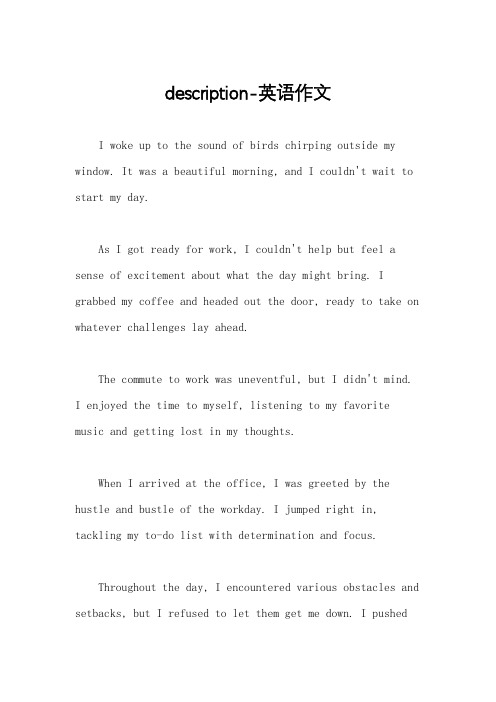
description-英语作文I woke up to the sound of birds chirping outside my window. It was a beautiful morning, and I couldn't wait to start my day.As I got ready for work, I couldn't help but feel a sense of excitement about what the day might bring. I grabbed my coffee and headed out the door, ready to take on whatever challenges lay ahead.The commute to work was uneventful, but I didn't mind.I enjoyed the time to myself, listening to my favorite music and getting lost in my thoughts.When I arrived at the office, I was greeted by the hustle and bustle of the workday. I jumped right in, tackling my to-do list with determination and focus.Throughout the day, I encountered various obstacles and setbacks, but I refused to let them get me down. I pushedthrough, finding solutions and staying positive in the face of adversity.As the day drew to a close, I felt a sense of accomplishment wash over me. Despite the challenges, I had managed to make progress and achieve my goals.Leaving the office, I felt a sense of satisfaction and pride. I knew that tomorrow would bring new challenges, but I was ready to face them head-on.。
英语作文description
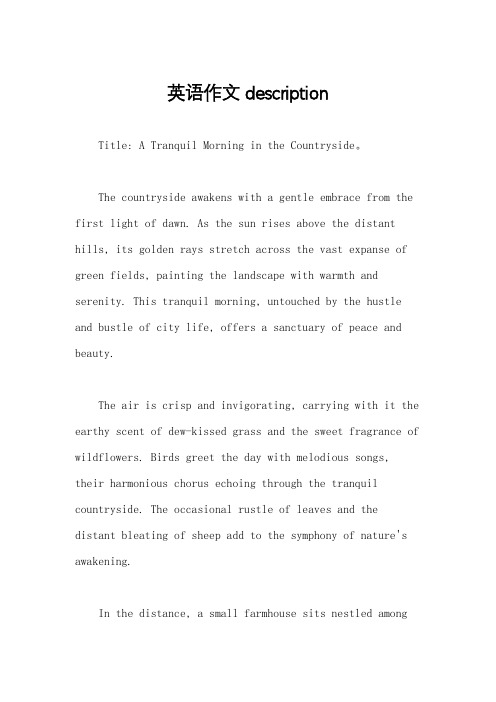
英语作文descriptionTitle: A Tranquil Morning in the Countryside。
The countryside awakens with a gentle embrace from the first light of dawn. As the sun rises above the distant hills, its golden rays stretch across the vast expanse of green fields, painting the landscape with warmth and serenity. This tranquil morning, untouched by the hustle and bustle of city life, offers a sanctuary of peace and beauty.The air is crisp and invigorating, carrying with it the earthy scent of dew-kissed grass and the sweet fragrance of wildflowers. Birds greet the day with melodious songs,their harmonious chorus echoing through the tranquil countryside. The occasional rustle of leaves and thedistant bleating of sheep add to the symphony of nature's awakening.In the distance, a small farmhouse sits nestled amongthe rolling hills, its weathered walls bathed in the soft glow of the morning sun. Smoke gently rises from the chimney, carrying the promise of a hearty breakfast cooked over an open fire. Nearby, a babbling brook winds its way through the landscape, its crystal-clear waters reflecting the azure sky above.As I take a leisurely stroll along the winding country lanes, I am greeted by friendly nods from passing farmers tending to their fields. The pace of life here is unhurried, allowing one to savor the simple joys of nature and the company of kindred spirits.In the meadows, wildflowers dance in the breeze, their vibrant hues a stark contrast to the lush greenery that surrounds them. Butterflies flit from flower to flower,their delicate wings shimmering in the morning light. Bees hum lazily as they go about their work, gathering nectar from the blossoms that adorn the countryside.I pause to admire the breathtaking beauty of the landscape spread out before me. The rolling hills, carpetedin a patchwork of emerald green, seem to stretch on for eternity, punctuated only by the occasional cluster of trees or quaint country cottage.As the morning unfolds, the countryside comes alive with activity. Farmers set out to tend to their crops, while children laugh and play in the meadows. The distant sound of church bells carries on the breeze, marking the passage of time in this idyllic corner of the world.In the distance, the silhouette of a lone oak tree stands sentinel against the horizon, its gnarled branches reaching towards the sky like outstretched arms. Beneathits shade, I find respite from the heat of the midday sun, allowing myself to be enveloped by the tranquility of the countryside.As the day draws to a close and the sun dips below the horizon, casting a warm orange glow across the landscape, I am filled with a sense of gratitude for the beauty that surrounds me. In this tranquil corner of the world, farremoved from the chaos of modern life, I find solace and serenity amidst the gentle embrace of nature.。
描述英语作文模板

描述英语作文模板Descriptive Essay Template。
Descriptive essays are a type of academic writing that requires students to describe a person, place, event, or object in detail. These essays are often assigned to help students develop their descriptive writing skills and to encourage them to use sensory details to create vivid descriptions. In this essay, I will provide a template for writing a descriptive essay.Introduction。
The introduction of a descriptive essay should provide the reader with a brief overview of what will be described in the essay. The introduction should also include a thesis statement that summarizes the main points of the essay.Body Paragraphs。
The body paragraphs of a descriptive essay should provide detailed descriptions of the person, place, event, or object being described. Each body paragraph should focus on a specific aspect of the subject and should include sensory details that help the reader visualize the subject.For example, if the essay is about a person, the body paragraphs could focus on the person's physical appearance, personality traits, and behaviors. Each paragraph should include sensory details that help the reader visualize the person. For example, the writer could describe the person's hair color, eye color, and clothing style, as well as their facial expressions and body language.Conclusion。
描述的三个维度英语作文
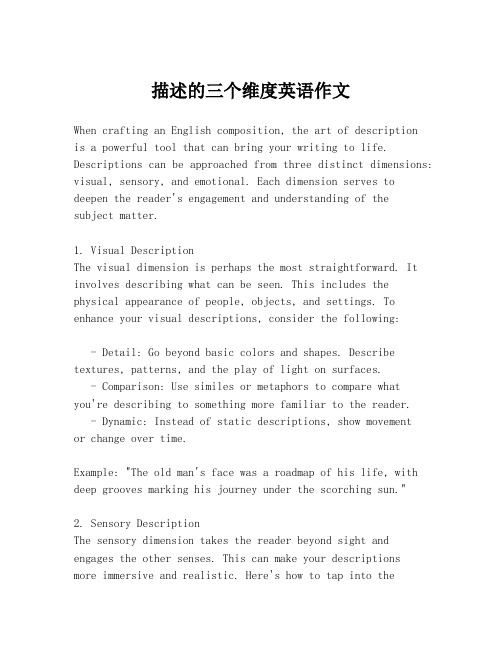
描述的三个维度英语作文When crafting an English composition, the art of descriptionis a powerful tool that can bring your writing to life. Descriptions can be approached from three distinct dimensions: visual, sensory, and emotional. Each dimension serves to deepen the reader's engagement and understanding of thesubject matter.1. Visual DescriptionThe visual dimension is perhaps the most straightforward. It involves describing what can be seen. This includes the physical appearance of people, objects, and settings. To enhance your visual descriptions, consider the following:- Detail: Go beyond basic colors and shapes. Describe textures, patterns, and the play of light on surfaces.- Comparison: Use similes or metaphors to compare whatyou're describing to something more familiar to the reader.- Dynamic: Instead of static descriptions, show movementor change over time.Example: "The old man's face was a roadmap of his life, with deep grooves marking his journey under the scorching sun."2. Sensory DescriptionThe sensory dimension takes the reader beyond sight and engages the other senses. This can make your descriptionsmore immersive and realistic. Here's how to tap into thesenses:- Sound: Describe the noises that fill the environment,from the rustling of leaves to the cacophony of a busy market. - Smell and Taste: These are powerful senses that canevoke strong memories and emotions. Describe the aroma of a freshly baked pie or the tangy taste of a ripe lemon.- Touch: Talk about the feel of different materials, the warmth of the sun, or the cold chill of a winter's morning.Example: "The air was thick with the scent of blooming jasmine, a fragrance so sweet it seemed to coat the back ofthe throat."3. Emotional DescriptionThe emotional dimension is subtler but can be the most impactful. It's about conveying the feelings and moods associated with the subject. Here's how to do it effectively:- Show, Don't Tell: Instead of saying "she was sad," describe her tear-streaked face and the quiver in her voice.- Internal Monologue: Give the reader insight into a character's thoughts and feelings.- Reaction: Describe how the environment or othercharacters react to the subject, which can imply emotions.Example: "Her laughter was contagious, a melodious ripplethat had heads turning and smiles forming around the room."By integrating these three dimensions into your English composition, you can create rich, multifaceted descriptionsthat not only inform but also engage and entertain your readers. Remember, the goal is to make your reader see, feel, and experience the world you are describing through your words.。
英语作文之Description

C h a p t e r 11 DescriptionThe writer of description creates a word-picture of persons, places, objects, and emotions, using a careful selection of details to make an impression on the reader. If you have already written expository or argumentative essays in your composition course, you almost certainly have written some descriptive prose. Nearly every essay, after all, calls for some kind of description; for example, in the student comparison/contrast essay (pages 233–236), the writer describes two kinds of stores; in the professional process essay (pages 215–219), the writer describes the embalming procedure in great detail. To help you write better description in your other essays, however, you may want to practice writing descriptive paragraphs or a short descriptive essay. HOW TO WRITE EFFECTIVE DESCRIPTIONWhen descriptive prose is called for in your writing, consider these four basic suggestions:Recognize your purpose. Description is not free-floating; it appears in your writing for a particular reason—to help you inform, clarify, persuade, or create a mood. In some essays you will want your description as objective—without personal impressions—as you can make it; for example, you might describe a scientific experiment or a business transaction in straight factual detail. Other times, however, you will want to convey a particular attitude toward your subject; this approach to description is called subjective or impressionistic. Note the differences between the following two descriptions of a tall, thin boy: the objective writer sticks to the facts by saying, “The eighteen-year-old boy was 6′1″ and weighed 125 pounds,” whereas the subjective writer gives an impressionistic description: “The young boy was as tall and scrawny as a birch tree in wint er.” Before you begin describing anything, you must first decide your purpose and then whether it calls for objective or subjective reporting.Describe clearly, using specific details. To make any description clear to your reader, you must include a sufficient number of details that are specific rather than fuzzy or vague. If, for example, your family dog had become lost, you wouldn’t call the animal shelter and ask if they’d seen a “big brown dog with a short tail”—aturally, you’d mention every disting uishing detail about your pet you could think of: size, color, breed, cut of ears, and special markings. Similarly, if your car was stolen, you’d give the police as clear and as complete a description of your vehicle as possible. Look at the following paragraph. Does it fully tell what a vaulting horse is?A vaulting horse is a thing usually found in gyms that has four legs and a beam and is used by gymnasts making jumps.If you didn’t already know what a vaulting horse was, you might have troub le picking it out in a gymnasium crowded with equipment. A description with additional details would help you locate it:A vaulting horse is a piece of equipment used by gymnasts during competition to help propel them into the air when they perform any of a variety of leaps known as vaults. The gymnasts usually approach the vaulting horse from a running start and then place their hands on the horse for support or for a push off as they perform their vaults. The horse itself resembles a carpenter’s s awhorse, but the main beam is made of padded leather rather than wood. The rectangular beam is approximately 5 feet, 3 inches long and 131⁄2 inches wide. Supported by four legs usually made of steel, the padded leather beam is approximately 4 feet, 1⁄2 inc h above the floor in men’s competitions and 3 feet, 7 inches in women’s competitions. The padded leather beam has two white lines marking off three sections on top: the croup, the saddle, and the neck. The two end sections—he croup and the neck—re each 151⁄2 inches long. Gymnasts place their hands on the neck or croup, depending on the type of vault they are attempting.Moreover, the reader cannot imagine your subject clearly if your description is couched in vague generalities. The following sentence, for example, presents only a hazy picture:Larry is a sloppy dresser.Revised, the picture is now sharply in focus:Larry wears dirty, baggy pants, shirts too small to stay tucked in, socks that fail to match his pants or each other, and a stained coat the Salvation Army rejected as a donation.Specific details can turn cloudy prose into crisp, clear images that can be reproduced in the mind like photographs.Select only appropriate details. In any description the choice of details d epends largely on the writer’s purpose and audience. However, many descriptions—especially the more subjective ones—ill present a dominant impression; that is, thewriter selects only those details that communicate a particular mood or feeling to the reader. The dominant impression is the controlling focus of a description; for example, if you wrote a description of your grandmother to show her thoughtfulness, you would select only those details that convey an impression of a sweet, kindly old lady. Here are two brief descriptions illustrating the concept of dominant impression. The first writer tries to create a mood of mystery:Down a black winding road stands the abandoned old mansion, silhouetted against the cloud-shrouded moon, creaking and moaning in the wet, chill wind.The second writer tries to present a feeling of joy and innocence.A dozen kites filled the spring air, and around the bright picnic tables spread with hot dogs, hamburgers, and slices of watermelon, Tom and Annie played away the warm April day.In the description of the deserted mansion, the writer would have violated the impression of mystery had the sentence read, Down the black winding road stands the abandoned old mansion, surrounded by bright, multicolored tulips in early bloom.Including the cheerful flowers as a detail in the description destroys the dominant mood of bleakness and mystery. Similarly, the second example would be spoiled had the writer ended it this way:Tom and Annie played away the warm April day until Tom got so sunburned he became ill and had to go home. Therefore, remember to select only those details that advance your descriptive purpose. Omit any details you consider unimportant or distracting.See if you can determine the dominant impression of each of the following descriptions:The wind had curled up to sleep in the distant mountains. Leaves hung limp and motionless from the silent trees, while birds perched on the branches like little statues. As I sat on the edge of the clearing, holding my breath, I could hear a squirrel scampering through the underbrush. Somewhere far away a dog barked twice, and then the woods were hushed once more.This poor thing has seen better days, but one should expect the sofa in a fraternity house den to be well worn. The large, plump, brown corduroy pillows strewn lazily on the floor and propped comfortably against the threadbare arms bear the pencil-point scars of frustrated students and foam-bleeding cuts of multiple pillow wars. No less than four pairs of rotting Nikes stand twenty-four-hour guard at the corners of its carefully mended frame. Obviously the relaxed, inviting appearance masks the permanent odors of cheap cigars and Michelob from Thursday night poker parties; at least two or three guests each weekend sift through the popcorn kernels and Doritos crumbs, sprawl face down, and pass out for the duration. However, frequent inhabitants have learned to avoid the dark stains courtesy of the house pup and the red-punch designs of the chapter klutz. Habitually, they strategically lunge over the back of the sofa to an unsoiled area easily identifiable in flight by the large depression left by previous regulars. The quiet hmmph of the cushions and harmonious squeal of the exhausted springs signal a perfect landing and utter a warm greeting from an old and faithful friend.Make your descriptions vivid. By using clear, precise words, you can improve any kind of writing. Chapters 7 (on words) and 6 (on sentences) offer a variety of tips on clarifying your prose style. In addition to the advice given there, here are two other ways to enliven your descriptions, particularly those that call for a subjective approach:Use sensory details. If it’s appropriate, try using images that appeal to your readers’ five senses. If, for example, you are describing your broken leg and the ensuing stay in a hospital, tell your readers how the place smelled, how it looked, what your cast felt like, how your pills tasted, and what noises you heard. Here are some specific examples using sensory details: Sight The clean white corridors of the hospital resembled the set of a sci-fi movie, with everyone scurrying around in identical starched uniforms.Hearing At night, the only sounds I heard were the quiet squeakings of sensible white shoes as the nurses made their rounds.Smell The green beans on the hospital cafeteria tray smelled stale and waxy, like crayons.Touch The hospital bed sheet felt as rough and heavy as a feed sack.Taste Every four hours they gave me an enormous gray pill whose aftertaste reminded me of the stale licorice my grandmother kept in candy dishes around her house.By appealing to the readers’ senses, you better enable them to identify with and imagine the subject you are describing. Joseph Conrad, the famous nineteenth-century novelist, agreed, believing that all art “appeals primarily to the senses, and the artistic aim when expressing itself in written words must also make its appeal through the senses, if its highest desire is to reach the secret spring of responsive emotions.” In other words, to make your readers feel, first make them “see.”Use figurative language when appropriate. As you may recall from Chapter 7, figurative language produces images or pictures in the readers’ minds, helping them to understand unfamiliar or abstract subjects. Here are some devices you might use to clarify or spice up your prose:1. Simile: a comparison between two things using the words “like” or “as” (see also pages 167–68)Example Seeing exactly the shirt he wanted, he moved as quickly as a starving teenager spotting pie in a refrigerator full of leftover vegetables.2. Metaphor: a direct comparison between two things that does not use “like” or “as” (see also pages 167–68)Example After the holidays, her body resembled the “before” shots in every diet ad she’d ever seen.3. Personification: the attribution of human characteristics and emotions to inanimate objects, animals, or abstract ideas Example The old teddy bear sat in a corner, dozing serenely before the fireplace.4. Hyperbole: intentional exaggeration or overstatementExample He was so lazy he worked nights as a futon.5. Understatement: intentional representation of a subject as less important than the facts would warrant (see also irony, page 153)Example “The reports of my death are greatly exaggerated.”—ark Twain6. Synecdoche: a part of something used to represent the wholeExample A hundred tired feet hit the dance floor for one last jitterbug. [Here “feet” stand for the dancing couples themselves.] Using figures of speech in appropriate places can make your descriptions clear, lively, and memorable.Problems to AvoidKeep in mind these three pieces of advice to solve problems that frequently arise in description:Remember your audience. Sometimes the object of our description is so clear in our minds we forget that our readers haven’t seen it, too. Consequently, the description we write turns out to be vague, bland, or skimpy. Ask yourself about your audience: what do they need to know to see this sight as clearly as I do? Then fill in your description with ample, precise details that reveal the best picture possible. Don’t forget to define or explain any terms you use that may be puzzling to your audience.Avoid an erratic organization of details. Too often descriptions are a hodgepodge of details, jotted down randomly. When you write a lengthy description, you should select a plan that will arrange your details in an orderly fashion. Depending on your subject matter and your purpose, you might adopt a plan calling for a description of something from top to bottom, left to right, front to back, and so on. For example, a description of a woman might begin at the head and move to the feet; furniture in a room might be described as your eyes move from one side of the room to another. A second plan for arranging details presents the subject’s outstanding characteristics first and then fills in the lesser informatio n; a child’s red hair, for example, might be his most striking feature and therefore would be described first. A third plan presents details in the order you see them approaching: dust, then a car, then details about the car, its occupants, and so on. Or you might describe a subject as it unfolds chronologically, as in some kind of process or operation. Regardless of which plan of organization you choose, the reader should feel a sense of order in your description.Avoid any sudden change in perspective. If, for example, you are describing the White House from the outside, don’t suddenly include details that could be seen only from inside. Similarly, if you are describing a car from a distance, you might be able to tell the car’s model, year, and color, but you could hardly describe the upholstery or reveal the mileage. It is, of course, possible for you—r your observer—o approach or move around the subject of your description, but the reader must be aware of this movement. Any shift in point of view must be presented clearly and logically, with no sudden, confusing leaps from a front to a back view, from outside to inside, and so on.ESSAY TOPICSHere are some suggestions for a descriptive paragraph or essay; narrow your topic to fit your assignment. Don’t fo rget thatevery description, whether objective or subjective, has a purpose and that every detail should support that purpose. For additional ideas, see “Suggestions for Writing” following the professional essay (page 336).1. A building or place you’re fo nd of2. Your best/worst job3. A piece of equipment important to your major, a hobby, or favorite sport4. A campus or local character5. One dish or foodstuff that should be forever banned6. The most creative area of your life7. Your most precious material possession8. The ugliest/most beautiful place on your campus or in town9. A holiday dinner or ritual in your home10. Your first or worst car or apartment11. A piece of clothing that reveals the real “you”12. A product that needs to be invented13. An act of heroism or personal success14. A favorite painting, sculpture, or other art object15. An unforgettable moment16. An event, element, or critter in nature17. A shopping mall, student cafeteria, or other crowded public place18. The inside of your refrigerator, closet, or some other equally loathsome place in your home19. A special collection or hobby display20. The best beach, ski slope, hiking trail, or other recreation spotA Topic Proposal for Your EssaySelecting the right subject matter is important to every writer. To help you clarify your ideas and strengthen your commitment to your topic, here is a proposal sheet that asks you to describe some of your preliminary ideas about your subject before you begin drafting. Although your ideas may change as you write (they will almost certainly become more refined), thinking through your choice of topic now may help you avoid several false starts.1. What subject will your essay describe? Will you describe this subject objectively or subjectively? Why?2. Why are you interested in this topic? Do you have a personal or professional connection to the subject? State at least one reason for your choice of topic.3. Is this a significant topic of interest to others? Why? Who specifically might find it interesting, informative, or entertaining?4. In one or two sentences describe the major effect you’d like your descriptive essay to have on your readers. What would you like for them to understand or “see” about your subject?5. List at least three details that you think will help clarify your subject for your readers.6.What difficulties, if any, might arise during drafting? For example, what organizational strategy might you think about now that would allow you to guide your readers through your description in a coherent way?SAMPLE STUDENT ESSSAYIn her descriptive essay, this student writer recalls her childhood days at the home of her grandparents to make a point about growing up. Notice that the writer uses both figurative language and contrasting images to help her readers understand her point of view.TREECLIMBING1 Introduction: The conversation that triggers her memory It was Mike’s eighteenth birthday and he was having a little bit of a breakdown. “When was the last time you ma de cloud pictures?” he asked me absently as he stared up at the ceiling before class started. Before I could answer, he continued, “Did you know that by the time you’re an adult, you’ve lost 85 percent of your imagination?” He paused. “I don’t want to grow up.” Although I doubted the authenticity of his facts, I understood thatMike—the hopeless romantic with his long ponytail, sullen black clothes, and glinting dark eyes—was caught in a Peter Pan complex. He drew those eyes from the ceiling and focused on me. “There are two types of children. Tree children and dirt children. Kids playing will either climb trees or play in the dirt. Tree children are the dreamers—the hopeful, creative dreamers. Dirt children, they just stay on the ground. Stick to the rules,” he trailed off, and then picked up again. “I’m a tree child. I want to make cloud pictures and climb trees. And I don’t ever want to come down.”Mike’s story reminded me of my own days as a tree child, and of the inevitable fall from the tree to the ground.2 The grandparents’ neighborhood remembered in military images and sensory details My childhood was a playground for imagination. Summers were spent surrounded by family at my grandparents’ house in Milwaukee, Wisconsin. The rambling Lannonstone bungalow was located on North 46th Street at Burleigh, a block away from center-city Milwaukee, two blocks from Schuster’s department store and the Pfister hotel. In the winter, all the houses looked alike, rigid and militant, like white-bearded old generals with icicles hanging from their moustaches. One European-styled house after the other lined the streets in strict parallel formation, block after block.3 But in the summer it was different . . . softer. No subzero winds blew lonely down the back alley. Instead, kids played stickball in it. I had elegant, grass-stained tea parties with a neighborhood girl named Shelly, while my grandfather worked in his thriving vegetable garden among the honeybees, and watched things grow. An ever-present warming smell of yeast filtered down every street as the nearby breweries pumped a constant flow of fresh beer. Looking up, the summer sky looked like an Easter egg God had dipped in blue dye.4 Use of parallel sentences to emphasize anticipation Those summer trips to Milwaukee were greatly anticipated events back then. My brother and I itched with repressed energy throughout the long plane ride from the West Coast. We couldn’t wait to see Grandma and Papa. We couldn’t wait to see what presents Papa had for us. We couldn’t wai t to slide down the steep, blue-carpeted staircase on our bottoms, and then on our stomachs. Most of all, we couldn’t wait to go down to the basement.5 The basement was better than a toy store. Yes, the old-fashioned milk chute in the kitchen wall was enchanting, and the laundry chute was fun because it was big enough to throw down Ernie, my stuffed dog companion, so my brother could catch him below in the laundry room, as our voices echoed up and down the chute. But the basement was better than all of these, better even than sliding down those stairs on rug-burned bottoms.6 The basement in contrast to other parts of the house It was always deliciously cool down in the basement. Since the house was built in the ’30s, there was no air conditioning. Upstairs, we slept in hot, heavy rooms. My nightgown stuck to the sheets, and I would lie awake, listening to crickets, inhaling the beer-sweet smell of the summer night, hoping for a cool breeze. Nights were forgotten, however, as my brother and I spent hours every day in the basement. There were seven rooms in the basement; some darker rooms I had waited years to explore. There was always a jumbled heap of toys in the middle room, most of which were leftovers from my father’s own basement days. It was a child’s s afe haven; it was a sacred place.7 Adventures in the basementThe times spent in the basement were times of a gloriously secure childhood. Empires were created in a day with faded colored building blocks. New territories were annexed when either my brother or I got the courage to venture into one of those Other Rooms—the dark, musty ones without windows—and then scamper back to report of any sightings of monsters or other horrific childhood creatures. In those basement days everything seemed safe and wholesome and secure, with my family surrounding me, protecting me. Like childhood itself, entering the basement was like entering another dimension.8 The house and neighborhood years later Last summer I returned to Milwaukee to help my grandparents pack to move into an apartment. I went back at 17 to find the house—my kingdom—up for sale. I found another cycle coming to a close, and I found myself separated from what I had once known. I looked at the house. It was old; it was crumbling; it needed paint. I looked down the back alley and saw nothing but trash and weeds. I walked to the corner and saw smoke-choked, dirty streets and thick bars in shop windows, nothing more than another worn-out mid-western factory city. I went back to the house and down to the basement, alone.9 The basement years later It was gray and dark. Dust filtered through a single feeble sunbeam from a cracked window pane. It was empty, except for the overwhelming musty smell. The toys were gone, either packed or thrown away. As I walked in and out of rooms. the quietness filled my ears, but in the back of my head the sounds of childhood laughter and chatter played likean old recording.10 The dark rooms were filled not with monsters but with remnants of my grandfather’s business. A neon si gn was propped against the wall in a corner: Ben Strauss Plumbing. Piles of heavy pipes and metal machine parts lay scattered about on shelves.A dusty purple ribbon was thumbtacked to a door. It said SHOOT THE WORKS in white letters. I gently took it down. The ribbon hangs on my door at home now, and out of context it somehow is not quite so awe-inspiring and mystifying as it once was. However, it does serve its purpose, permanently connecting me to my memories.11 Conclusion: A return to the introduction’s images and some advice All children are tree children, I believe. The basement used to be my tree, the place I could dream in. That last summer I found myself, much to Mike’s disappointment, quite mature, quite adult. Maybe Mike fell from his tree and go t bruised. Climbing down from that tree doesn’t have to be something to be afraid of. One needn’t hide in the tree for fear of touching the ground and forgetting how to climb back up when necessary. I think there is a way to balance the two extremes. Climb down gracefully as you grow up, and if you fall, don’t land in quicksand. I like to think I’m more of a shrubbery child: not so low as to get stuck in the mud and just high enough to look at the sky and make cloud pictures.PROFESSIONAL ESSAY* To help you read this essay analytically, review pages 176–178. For two other professional essays in Part Two that make extensive use of description, see “To Bid the World Farewell” and“Two Ways of Viewing the River.”Still Learning from My MotherCliff SchneiderCliff Schneider is a graduate of Cornell and a retired freshwater fisheries biologist, who worked for the Department of Environmental Conservation in New York. Much of his research and writing has focused on his work studying Lake Ontario. This essay, a personal tribute to his seventy-nine-year -old mother, was first published in the “My Turn” column of Newsweek magazine, in March 2000.1 When I was a young boy growing up on New York’s Long Island in the 1950s, it was common to see boys and their fathers gathering in the roads in front of their homes on warm summer evenings to “have a catch.” That was the term we had for tossing a baseball while we talked about school, jobs and life in general. Although my dad and I had many catches together, my most memorable ones were with my mother. She would happily grab a glove, run out to the road and then fire fast balls at me that cracked my glove and left my hand stinging. She never showed any motherly concern, though, just a broad grin with the tip of her tongue exposed in the corner of her mouth. This was her game face. I can still recall how delighted I was tossing the ball with Mom and hearing the comments from my friends and neighbors: “Where did your mother learn to throw a ball like that?”2 My mother, you see, was a jock long before Title IX unleashed the explosion of modern women’s athletics. She lettered in field hockey and basketball while attending Hofstra University in the late 1930s. This was a time when it wasn’t very fashionable for women to go running after a ball and work up a sweat. Luckily for me, Mom never worried about what was fashionable. She loved sports, loved being active and, most of all, loved the competition. Mom was kind to her kids until we played ball. Then we’d notice this gleam in her e ye, the broad grin and the familiar tongue that told us she was ready for action and ready to have some fun. No matter what game she played, Mom had class. She played hard, she laughed a lot and, win or lose, she was always gracious.3 The years have dimin ished Mom’s physical abilities, as they would have for anyone who is about to become an octogenarian. Her back is a little bent, and she complains occasionally about her hip. Her biggest concession to the aging process, however, is that she has had to lighten up on her bowling ball. As a young mother in suburban bowling leagues she toted a 15-pound ball, carried a 160 average and had a high game of 212. As she’s grown older, her scores have declined. In recent years she’s had to start using an eight-pound ball, which she protests is too light and “doesn’t give enough pin action.”4 For years I have had to listen to my mother’s perennial battle cry as she begins each new bowling season—“This is the year I’m going to bowl a 200 game!” I’ve always smiled and no dded in agreement, which was my way of acknowledging her determination. During our regular Thursday-evening phone conversations (she bowls on Thursdays), she gives me a frame-by-frame description of her games, and gripes that she can’t bowl the way she used to. She almost always slips in the comment “I’m going to make 200 if it kills me.” I try to explain that she should be satisfied that she is at least able to play thegame. “Try to make some concession to your age, Mom,” I say. Of course, she will have n one of this talk and this year bought a 10-pound ball in pursuit of her dream. Vince Lombardi would be proud.5 A week after she started bowling with her new ball, I called to check on her progress. She no sooner said “Hi” than I could tell something big had happened in her life. I could feel the smile all the way from Hendersonville, N.C., to upstate New York. I shouted, “You bowled a 200 game!” knowing it could be the only reason for such a happy voice. She corrected me: “Not a 200 game; I got a 220.” It was her highest score ever! She gave me a strike-by-strike description of her game, and we both celebrated over the phone. As she signed off and said her goodbyes, I could still sense the smile on her face. Her grin will probably fade in another month or two.6 After some reflection, I am amazed by my mother’s accomplishment. Whether it is baseball, tennis, golf or even bowling, I have never heard of anyone’s peaking at 79. Yes, there is some degree of luck in every game,but in Mom’s case she had the best game of her life because she persevered. Mom’s achievement has lifted her spirits and made her feel young again. For someone who is too frequently reminded that she can’t do what she used to, this experience could not have come at a better time in her life. I guess I’m not surprised that I can still learn from Mom—hat you are never too old to dream and never too old to realize those dreams. I am not surprised, either, that in our most recent calls she talks about bowling a 250 game.Questions on Content, Structure, and Style1. Is Schneider’s description of his mother primarily objective or subjective? Cite an example of his language to support your answer.2. Why was his mother’s behavior unusual in the 1950s? What does “before Title IX” (paragraph 2) mean?3. How does Schneider physically describe his mother so that readers can easily imagine those early games of catch? Why does she have “class”?4. Examine some of Schneider’s word choices. What, for example, is the effect of writing that his mother would “fire fast balls at me that cracked my glove and left my hand stinging” (paragraph 1) instead of“mom could throw very hard”?5. What does his mother’s “perennial battle cry” at age 79 reveal about her? Why does Schneider think Vince Lombardi—he football coach who holds the record for the most NFL wins—ould be proud of her?6. What “dominant impression” of his mother does Schneider present in this essay? What are some of the details Schneider provides to help us understand this woman’s character?7. What doe s Schneider’s occasional use of dialogue add to this essay?Why, for example, does he quote his neighbors in paragraph 1 and his mother in paragraphs 3 and 4?8. Why does Schneider organize his essay by starting with a description of his mother’s younger d ays and concluding with a reference to “a250 game”? How does this organization contribute to our understanding of his mother?9. What has Schneider learned from his mother? In what way is this lesson an important part of this essay’s purpose?10. Did Schneider successfully create a picture of his mother? Could you suggest some ways he might improve his description? What language might have been more specific or vivid?Suggestions for WritingTry using Cliff Schneider’s “Still Learning from My Mother” a s a steppingstone to your essay. Describe an unusual-but-wonderful relative or friend you admire for a particular trait. Consider including ample physical details, dialogue, and actions illustrating personality, as Schneider did, to make your description of this person vivid for your reader. Or write a description of an ancestor whose photograph has always intrigued you. What is the dominant impression of this picture? What does this person’s face (and perhaps choice of clothing? ) say to you about his or her character? Perhaps you might choose a photograph (or memory) of yourself on a special occasion. Write a description of yourself using a generous number of specific details and figurative language to capture the dominant impression of the picture.VocabularyTitle IX (2) diminished (3) octogenarian (3) concession (3) toted (3) perennial (4)A REVISION WORKSHEETAs you write your rough drafts, consult Chapter 5 for guidance through the revision process. In addition, here are a few questions to ask yourself as you revise your description:。
英语作文写作之Description_描写
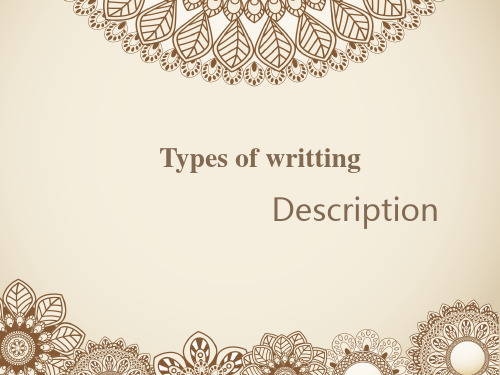
Descriptive Essay
Goal is to share an experience with the reader appealing to their senses. How does the last sentence about the fan appeal to the senses?
批注本地保存成功开通会员云端永久保存去开通
Types of writting
Description
Writing Descriptions
In the window was a fan.
The blades of the rusty window fan clattered and whirled as they blew out a stream of warm, soggy air.
Question- example 1 Does the author have a thesis?
Can you picture this ‘perfect restaurant’ the author describes?
Pro essay- Body 1
At Lou ’ s Kosy Korner Koffee Shop, the mock abuse flows like a cup of spilled Folgers. Customers are yelled at, lectured, blamed, mocked, teased, and ignored. They pay for the privilege of pouring their own coffee and scrambling their own eggs.
Intro/Conclusion-
中学英语作文类型description

中学英语作文类型description**Description** is a fundamental genre in English writing, especially in secondary school education. It involves the art of representing objects, places, people,or events in a vivid and descriptive manner, aiming toevoke a clear mental image for the reader. In this genre,the writer is expected to capture the essence of thesubject matter through meticulous observation and the useof descriptive language.To master the skill of description, one must possess a keen sense of observation, an understanding of language techniques, and the ability to organize ideas in a logical and coherent manner. Let's delve deeper into the various aspects of writing a descriptive essay.**1. Choosing a Topic**The first step in writing a descriptive essay is selecting a topic. Topics can range from simple objectslike a flower or a pen to complex ones like a festival or a person's personality. It's important to choose a topic that interests you and that you feel passionate about describing.**2. Observing the Subject Matter**Observation is crucial in descriptive writing. Examine your subject closely, noting its appearance, texture, color, shape, and any other physical characteristics that stand out. Additionally, consider its function or significance,if applicable.**3. Organizing Your Thoughts**Before you begin writing, it's essential to organize your thoughts. Decide on the order in which you willpresent the information about your subject. You might wantto start with a general overview and then move on to more specific details, or vice versa.**4. Using Descriptive Language**The key to effective descriptive writing is using vivid and感官性的语言. Employ adjectives, adverbs, andfigurative language to create a vivid picture in thereader's mind. Use similes and metaphors to compare and contrast your subject with familiar objects or experiences. **5. Structuring the Essay**A descriptive essay typically follows the standardessay structure of introduction, body, and conclusion. The introduction should introduce the subject and give a brief overview of what the essay will cover. The body paragraphs should develop the description in detail, focusing on different aspects of the subject. The conclusion should sum up the main points and leave a lasting impression on the reader.**6. Revising and Editing**After completing the first draft, it's important to revise and edit your work. Check for grammar errors,spelling mistakes, and inconsistencies in language use. Ensure that your description is clear, coherent, and engaging.**中学英语作文类型之“Description”深度解析** “Description”(描述)是英语写作中的一种基础文体,尤其在中学教育中占据重要地位。
经历描述英语作文模板
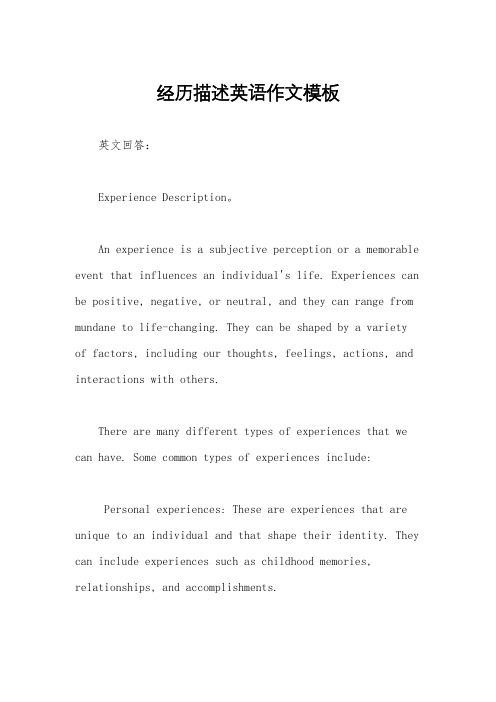
经历描述英语作文模板英文回答:Experience Description。
An experience is a subjective perception or a memorable event that influences an individual's life. Experiences can be positive, negative, or neutral, and they can range from mundane to life-changing. They can be shaped by a variety of factors, including our thoughts, feelings, actions, and interactions with others.There are many different types of experiences that we can have. Some common types of experiences include:Personal experiences: These are experiences that are unique to an individual and that shape their identity. They can include experiences such as childhood memories, relationships, and accomplishments.Social experiences: These are experiences that we have with others and that shape our social identity. They can include experiences such as friendships, family relationships, and community involvement.Educational experiences: These are experiences that we have in school or other educational settings. They can include experiences such as learning new skills, studying different subjects, and taking tests.Work experiences: These are experiences that we havein the workplace. They can include experiences such as working on projects, interacting with colleagues, and managing responsibilities.Travel experiences: These are experiences that we have when we travel to new places. They can include experiences such as seeing new sights, meeting new people, and trying new things.All of these different types of experiences can have a significant impact on our lives. They can help us to learnand grow, develop new skills, and build relationships. They can also help us to cope with challenges, overcome obstacles, and achieve our goals.Writing an Experience Description。
英语作文范文-描写文 (Description)写作

英语作文范文描写文 (Description)写作(一) 定义描写文是用生动的语言描写各种事物、环境以及人物的状态、表现等的文体。
(二) 描写的种类1. 人物描写(1) 人物外貌描写(2) 语言行动描写(3) 心理活动描写2. 景物描写(1) 动态描写(2) 静态描写3. 场面描写(三) 范文评析Sample 1Directions: For this part, you are allowed thirty minutes to write a composition of no less than 150 words on My English Teacher. Remember to write clearly.My English TeacherMy English teacher is a woman of medium-height. She isin her thirties. She always has a smile on her face and a kind word for her students. As she is also a little plump, she gives people the impression that she is a patient, responsible and easygoing teacher.This picture of my teacher is true. She devotes herself to the cause of education. She prepares and organizes her lessons so well that we are fully attentive in her class. After class she often gives lessons to the students who have been absent from school because of illness. With her help we have become more and more interested in our English study. Whenever we have problems we will turn to her for help. As a matter of fact, she is more an intimate friend to us than a respected teacher.We have learnt a great deal from her devotion to her work, her conscientiousness in teaching, and her readiness to help others.Sample 2Directions: For this part, you are allowed thirty minutes to write a composition of no less than 150 words on The Spring Festival. Remember to write clearly.The Spring FestivalThe Spring Festival is the Chinese Lunar New Year. It’s the most important holiday in China. People usually celebrate and spend the Spring Festival together with their parents and children at home.With the New Year round the corner, every family is busy getting ready for it. All the housewives at this time would give their house an extra cleaning, make al the things clean, tidy and keep everything in its right place.On New Year’s Eve, every family makes dumplings and cook many delicious dishes. All the members of the family gather together and have a family dinner. After the big meal, they watch TV to enjoy the programs specially prepared for the Festival. The children let off fireworks, men play Mahjong and cards. They stay up very late. Just a t midnight, when the clock strikes twelve, they let off various firecrackers outdoors to see the Old Year off and the New Year in.评析:本文采用三段式的行文形式,首段介绍春节是中国农历新年。
人物外貌描写英语作文
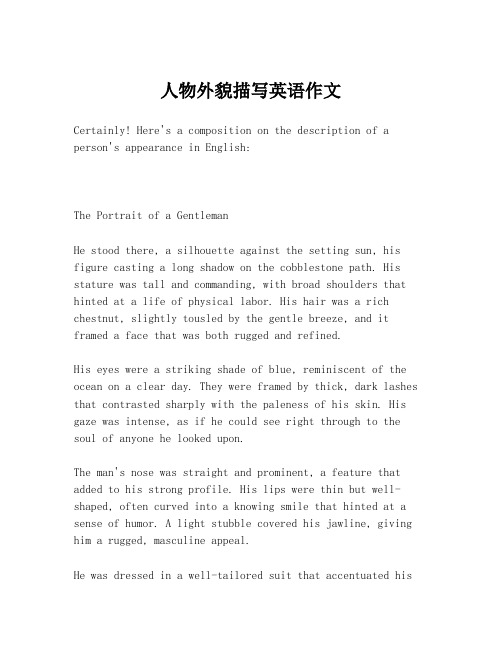
人物外貌描写英语作文Certainly! Here's a composition on the description of a person's appearance in English:The Portrait of a GentlemanHe stood there, a silhouette against the setting sun, his figure casting a long shadow on the cobblestone path. His stature was tall and commanding, with broad shoulders that hinted at a life of physical labor. His hair was a rich chestnut, slightly tousled by the gentle breeze, and it framed a face that was both rugged and refined.His eyes were a striking shade of blue, reminiscent of the ocean on a clear day. They were framed by thick, dark lashes that contrasted sharply with the paleness of his skin. His gaze was intense, as if he could see right through to the soul of anyone he looked upon.The man's nose was straight and prominent, a feature that added to his strong profile. His lips were thin but well-shaped, often curved into a knowing smile that hinted at a sense of humor. A light stubble covered his jawline, giving him a rugged, masculine appeal.He was dressed in a well-tailored suit that accentuated hislean physique. The fabric was of the finest quality, and the cut was impeccable, suggesting a man of taste and means. His shoes were polished to a mirror shine, and they clicked rhythmically against the pavement as he walked.Despite his imposing presence, there was a certain warmth about him. His hands, large and capable, moved with a gentle grace that was at odds with his rugged exterior. He carried himself with an air of confidence, yet there was a softnessin his demeanor that made him approachable.In the fading light, he seemed to embody the essence of a gentleman—a man of strength, elegance, and kindness. His appearance was not just a reflection of his physical attributes but also a testament to his character and the life he had lived.This composition focuses on the detailed description of a man's appearance, using vivid imagery and descriptive language to paint a picture of his physical features, attire, and the aura he projects.。
描述人物的英语作文
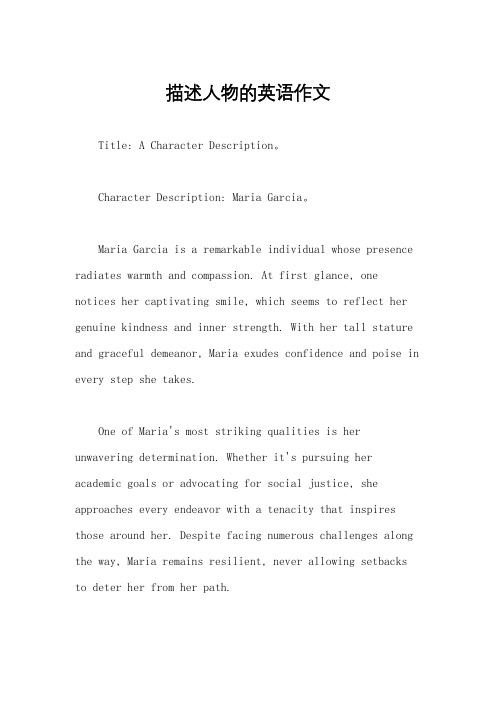
描述人物的英语作文Title: A Character Description。
Character Description: Maria Garcia。
Maria Garcia is a remarkable individual whose presence radiates warmth and compassion. At first glance, one notices her captivating smile, which seems to reflect her genuine kindness and inner strength. With her tall stature and graceful demeanor, Maria exudes confidence and poise in every step she takes.One of Maria's most striking qualities is her unwavering determination. Whether it's pursuing her academic goals or advocating for social justice, she approaches every endeavor with a tenacity that inspires those around her. Despite facing numerous challenges along the way, Maria remains resilient, never allowing setbacks to deter her from her path.In addition to her resilience, Maria possesses a remarkable intellect. As a dedicated student, she consistently demonstrates a thirst for knowledge and a passion for learning. Whether she's engaged in a lively classroom discussion or delving into complex research projects, Maria's intellectual curiosity shines through, captivating the minds of her peers and educators alike.Beyond her academic pursuits, Maria is deeply committed to making a positive impact in her community. Whether it's volunteering at local shelters, organizing fundraisers for charitable causes, or participating in advocacy campaigns, she tirelessly works to uplift those in need and amplify the voices of the marginalized.Maria's compassion knows no bounds, and she approaches every interaction with empathy and understanding. Whetherit's lending a listening ear to a friend in need oroffering words of encouragement to a stranger, she embodies the true essence of empathy, fostering connections and building bridges across diverse backgrounds.Furthermore, Maria is a natural leader who leads by example. Her strong sense of integrity and ethical values guide her actions, earning her the respect and admiration of her peers. Whether she's spearheading group projects or leading student organizations, Maria's inclusive leadership style fosters collaboration and empowers others to reach their full potential.In her spare time, Maria enjoys immersing herself in creative pursuits such as painting, writing, and photography. These artistic endeavors serve as outlets for self-expression and reflection, allowing her to recharge and find solace amidst life's demands.Overall, Maria Garcia is a multifaceted individual whose depth of character and unwavering commitment to excellence set her apart. With her compassion, resilience, intellect, and leadership skills, she embodies the values of empathy, integrity, and service, making her a true asset to her community and an inspiration to all who have the privilege of knowing her.。
描写人物特征,性格,本领,外貌的英语作文
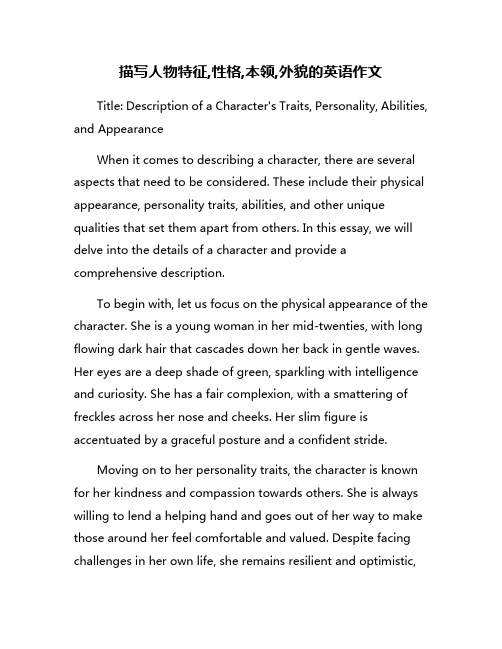
描写人物特征,性格,本领,外貌的英语作文Title: Description of a Character's Traits, Personality, Abilities, and AppearanceWhen it comes to describing a character, there are several aspects that need to be considered. These include their physical appearance, personality traits, abilities, and other unique qualities that set them apart from others. In this essay, we will delve into the details of a character and provide a comprehensive description.To begin with, let us focus on the physical appearance of the character. She is a young woman in her mid-twenties, with long flowing dark hair that cascades down her back in gentle waves. Her eyes are a deep shade of green, sparkling with intelligence and curiosity. She has a fair complexion, with a smattering of freckles across her nose and cheeks. Her slim figure is accentuated by a graceful posture and a confident stride.Moving on to her personality traits, the character is known for her kindness and compassion towards others. She is always willing to lend a helping hand and goes out of her way to make those around her feel comfortable and valued. Despite facing challenges in her own life, she remains resilient and optimistic,facing each obstacle with grace and determination. Her sense of humor is infectious, often bringing a smile to the faces of those she interacts with.In terms of abilities, the character possesses a keen intellect and a thirst for knowledge. She is a quick learner, absorbing information like a sponge and applying it to various situations with ease. Her creativity knows no bounds, as she is constantly coming up with innovative solutions to problems that others may find daunting. She is also a skilled communicator, able to articulate her thoughts and ideas with clarity and precision.Finally, let us discuss the character's unique qualities and strengths. She has a natural talent for music, with a voice that can mesmerize and enchant all who hear it. Her passion for art is evident in her paintings, which are vibrant and expressive, capturing the essence of the world around her. She is also a fierce advocate for social justice, using her voice to speak out against injustice and inequality wherever she may find it.In conclusion, this character is a complex and multi-faceted individual, with a wealth of traits, abilities, and qualities that make her truly remarkable. From her striking appearance to her kind-hearted nature, she is a person who leaves a lasting impression on all those who have the privilege of knowing her.。
人物描述英语作文
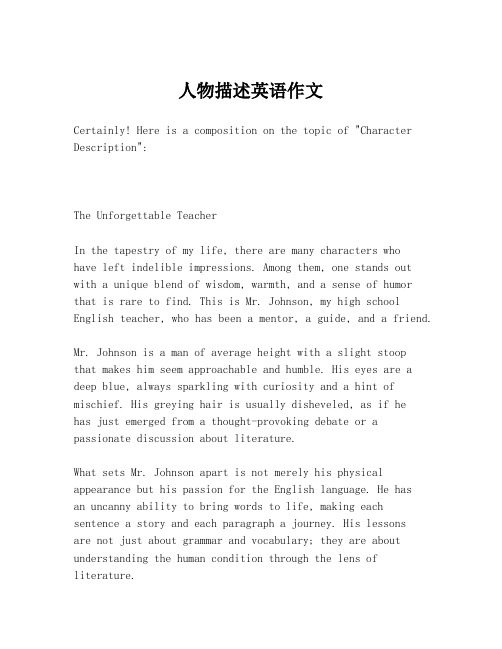
人物描述英语作文Certainly! Here is a composition on the topic of "Character Description":The Unforgettable TeacherIn the tapestry of my life, there are many characters whohave left indelible impressions. Among them, one stands out with a unique blend of wisdom, warmth, and a sense of humor that is rare to find. This is Mr. Johnson, my high school English teacher, who has been a mentor, a guide, and a friend.Mr. Johnson is a man of average height with a slight stoopthat makes him seem approachable and humble. His eyes are a deep blue, always sparkling with curiosity and a hint of mischief. His greying hair is usually disheveled, as if hehas just emerged from a thought-provoking debate or a passionate discussion about literature.What sets Mr. Johnson apart is not merely his physical appearance but his passion for the English language. He hasan uncanny ability to bring words to life, making each sentence a story and each paragraph a journey. His lessonsare not just about grammar and vocabulary; they are about understanding the human condition through the lens of literature.In the classroom, Mr. Johnson is a dynamic presence. He moves with an energy that belies his years, engaging students with his infectious enthusiasm. He is not one to stand behind a desk; instead, he roams the room, encouraging participation and fostering a sense of community. His teaching style is interactive and inclusive, making every student feel valued and heard.Outside of the classroom, Mr. Johnson is a beacon of support. He is always available to lend an ear or offer advice, whether it's about academic challenges or personal dilemmas. His office door is always open, and his desk is cluttered with books, papers, and the occasional student project that he takes the time to review.Mr. Johnson's impact extends beyond the walls of the school. He has inspired countless students to pursue their passions, whether in literature, writing, or any other field. His dedication to education is evident in the success stories of his former students, many of whom credit him for their achievements.In conclusion, Mr. Johnson is a character who has left a profound impact on my life and the lives of many others. His character is a testament to the power of a great teacher –one who not only imparts knowledge but also instills a love for learning and a sense of curiosity about the world. He is a character that will be remembered fondly for years to come.This composition provides a detailed and vivid description of a character, focusing on their personality traits, teaching style, and the impact they have had on students.。
现象描述类英语作文
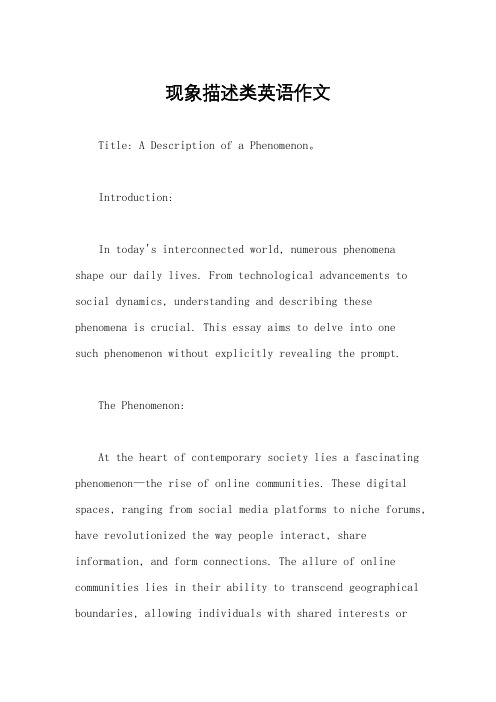
现象描述类英语作文Title: A Description of a Phenomenon。
Introduction:In today's interconnected world, numerous phenomena shape our daily lives. From technological advancements to social dynamics, understanding and describing these phenomena is crucial. This essay aims to delve into onesuch phenomenon without explicitly revealing the prompt.The Phenomenon:At the heart of contemporary society lies a fascinating phenomenon—the rise of online communities. These digital spaces, ranging from social media platforms to niche forums, have revolutionized the way people interact, share information, and form connections. The allure of online communities lies in their ability to transcend geographical boundaries, allowing individuals with shared interests oridentities to come together virtually.One notable aspect of this phenomenon is the sense of belonging and identity formation within these online spaces. Users often find like-minded individuals who understandtheir perspectives and experiences, fostering a sense of camaraderie and validation. Moreover, the anonymityafforded by the internet enables individuals to express themselves more freely, leading to the emergence of diverse subcultures and communities.Furthermore, online communities serve as hubs for knowledge exchange and collaboration. Whether it's seeking advice, sharing expertise, or collaborating on projects, these digital platforms facilitate learning and innovation on a global scale. From academic forums to hobbyist groups, individuals can tap into a wealth of collective wisdom and expertise, transcending traditional barriers to knowledge acquisition.However, alongside the benefits, there are also challenges inherent in this phenomenon. One such challengeis the issue of misinformation and echo chambers. In the absence of gatekeepers, misinformation can spread rapidly within online communities, leading to the proliferation of rumors and false narratives. Moreover, the tendency for individuals to gravitate towards like-minded peers can reinforce pre-existing beliefs, inhibiting criticalthinking and fostering polarization.Additionally, the phenomenon of online communitiesraises questions about privacy and security. With vast amounts of personal data being shared online, concernsabout data breaches and privacy violations are ever-present. Moreover, the anonymity of the internet can embolden individuals to engage in harmful behavior, such as cyberbullying or harassment, with impunity.Conclusion:In conclusion, the rise of online communitiesrepresents a multifaceted phenomenon that profoundlyimpacts contemporary society. From fostering connectionsand knowledge exchange to posing challenges such asmisinformation and privacy concerns, these digital spaces have become integral to our social and cultural fabric. Understanding and navigating this phenomenon requires critical reflection and proactive measures to harness its potential for positive change while mitigating its negative consequences. As we continue to navigate the digital landscape, it is imperative to cultivate a balance between connectivity and accountability, ensuring that online communities remain vibrant and inclusive spaces for all.。
- 1、下载文档前请自行甄别文档内容的完整性,平台不提供额外的编辑、内容补充、找答案等附加服务。
- 2、"仅部分预览"的文档,不可在线预览部分如存在完整性等问题,可反馈申请退款(可完整预览的文档不适用该条件!)。
- 3、如文档侵犯您的权益,请联系客服反馈,我们会尽快为您处理(人工客服工作时间:9:00-18:30)。
a topic/thesis details into some logical
List
details supporting thesis
Organize
order
Begin
1st draft
Intro/Conclusion-
Assignment- Descriptive Essay Write your own descriptive essay using a place familiar to you. a library study area a waiting room at a train station a small shop an internet bar a place in your hometown
As in a fond but dysfunctional family, Lou displays his affection through criticism and insults, and his customers respond in kind. If Lou ’ s had a slogan, it might be, ‚If I’m polite to you, ask yourself what’s wrong.‛
-Out-of-order neon sign
-Silent middle-aged couple
-Couldn’t see anyone in the kitchen
Assignment- Descriptive Essay
Organize
your list.
-by physical order: move from left to right, far to near ect.
Descriptive Essay
Make readers see, taste, hear, smell and feel. Give the reader a mental picture.
Pro essay- Intro Imagine a restaurant where your every whim is catered to, your every want satisfied, your every request granted without hesitation. The people on staff live to please you. They hover over you anxiously as you sample your selection, waiting for your judgment. Your pleasure is their delight, your dissatisfaction their dismay. Lou ’ s isn’t that kind of place.
-Size: Begin with large objects and work down to smaller ones -special order: use an order appropriate to your subject.
Assignment- Descriptive Essay
Develop
Descriptive Essay
Goal is to share an experience with the reader appealing to their senses. How does the last sentence about the fan appeal to the senses?
Question- body 1
Does the paragraph support the thesis? Do you get a sense of how Lou treats his costumers?
Байду номын сангаас
Pro essay- example 3 ‚ Maaaaakeee someone happy … Make-makemaaakeeee someone happy, ‛ he croons as he lifts the steaming pot that has infused the room with the rich aroma of freshly brewed coffee. He carries it to the woman ’ s table, fills her cup, and drops two single-serving containers of half and half nearby. Sight___ Sound___ Taste__ Smell__ Touch___
Assignment- Descriptive Essay
Once
you have a thesis, make a list of as many details as you can to support your general impression.
-Tired workers at the counter
Question- example 1 Does the author have a thesis?
Can you picture this ‘perfect restaurant’ the author describes?
Pro essay- Body 1
At Lou ’ s Kosy Korner Koffee Shop, the mock abuse flows like a cup of spilled Folgers. Customers are yelled at, lectured, blamed, mocked, teased, and ignored. They pay for the privilege of pouring their own coffee and scrambling their own eggs.
Assignment- Descriptive Essay
Remember:
you need a thesis.
ie: The train station waiting room was frightening. The exam room was tense. The study room was quiet.
Assignment #4 Edits
Unity-
Ask the question…
Support-
If you see a paragraph with three sentences….. paragraph sentences….. if you see a with one or two
Types of writting
Description
Writing Descriptions
In the window was a fan.
The blades of the rusty window fan clattered and whirled as they blew out a stream of warm, soggy air.
